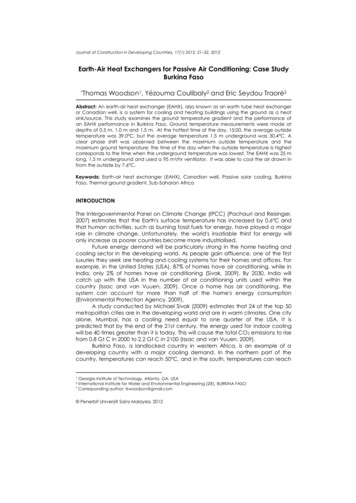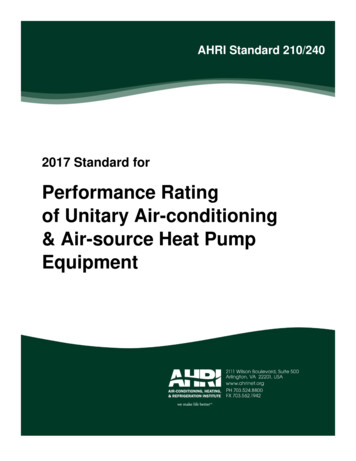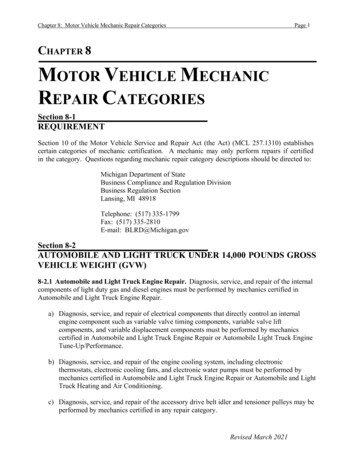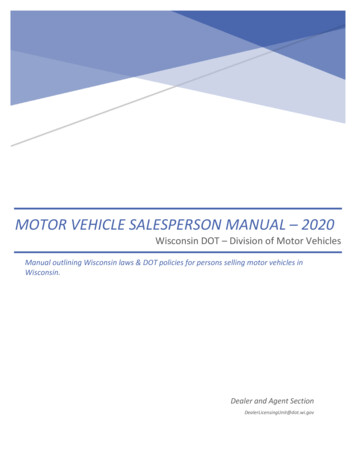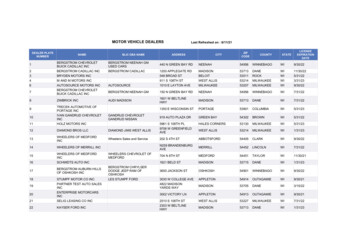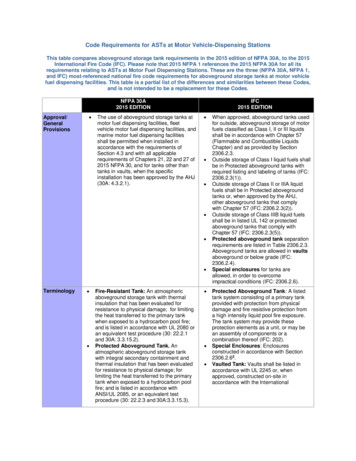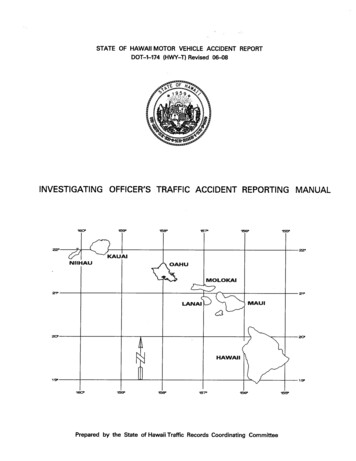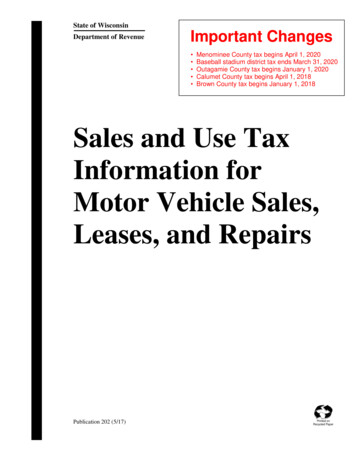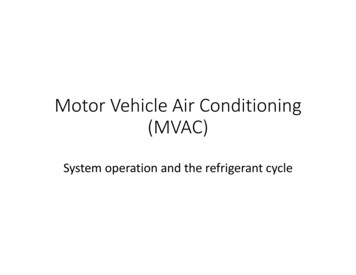
Transcription
Motor Vehicle Air Conditioning(MVAC)System operation and the refrigerant cycle
At Sea level ‐ water boils at 212⁰ F ‐ R‐134a boils at ‐15⁰ F
At Sea level ‐ ‐ R‐134a boils at ‐15⁰ FAt 30 psig ‐‐ R‐134a boils at 35⁰F evaporator will control it’s TemperatureThe Pressure of the
An R134a temperature‐pressure chart shows what the refrigeranttemperature should be at a specific pressure.This can be helpful in A/C diagnosis.MVAC systems that are low on refrigerant will have:Low pressures in Evaporator (low side) and Condenser (high side)MVAC systems that are overcharges with refrigerant will have:High pressures in Evaporator (low side) and Condenser (high side)
Low charge canfreeze the evaporatorLow charge equalspoor heat transferHigh charge givespoor heat transferat the evaporatorThe correct refrigerant charge ensures maximum heat transfer fromthe passenger compartment.
Low SideAbsorbing latent heatturns liquid to vaporHi SideReleasing latent heatturns vapor to liquid
2 types of MVAC systemsAll A/C systems use a compressor, condenser, evaporatorSome systems use the Expansion Valve with Receiver/DrierSome systems use the Fixed Orifice Tube with Accumulator
Receiver‐Driersend high pressureliquidto expansion valve
Receiver Drier will separateliquid from vapor refrigerantReceiver Drier will sendliquid refrigerant (high pressure)to the expansion valveOnly older R‐12 systems usethe sight glassVaporized refrigerantcollects at top of receiverReceiver drier will havedesiccant bag.Some desiccant bagscan be changedOther designs requirecomponent replacementLiquid refrigerant sinks tobottom and is sent toexpansion valve
Expansion valve CLOSES when evaporator is too COLDExpansion valve OPENS then evaporator is too WARM
Expansion Valves senseevaporator pressure and willopen or close to maintainideal pressure/temperature
Receiver ‐ Drier
Some systems use a fixed orifice tubeand Accumulator
AccumulatorSends low pressureVapor to compressorUsed with Orifice Tube
Accumulator will separate liquidfrom vapor refrigerantAccumulator will send Vaporrefrigerant (low pressure) to thecompressorAccumulator will have desiccantbag.Some desiccants can bechanged, other designs requirecomponent replacementVaporized refrigerantcollects at top of receiverand only low pressure vaporis returned to compressor
Fixed Orifice Tube
Many different types of compressors are used
Most compressors use an electric clutch to cycle compressorON and OFF to maintain proper evaporator pressure
Some compressors will not cycle ON/OFF and willvary the piston stroke to maintain evaporator pressure
Most Clutches are checked using a feeler gauge.
Adjusting ShimCoil ‐ MagnetCompressorSpring loaded Clutch PlateDrive Pulley
Any time you replace a compressor or clutch,the clearance must be checked.Loose clearance will cause clutch to make noise, slip, and overheat.Tight clearance can cause the clutch to stay mechanically engagedThis will raise pressure too high and may cause the pressure relief valve to open.Most Clutches are checked using a feeler gauge.Shims available in several thicknesses to adjust the clearance.
A/C Compressors require lubricating oil carried by the refrigerantRefrigerant oil specifications vary between A/C compressor designsand manufacturers.Always look up and use the correct oil for your system.The oil type can be identified by a tag located on the compressor bodyor in the service manual.
Using the wrong type of compressor oil may cause excessivenoise and shorten the A/C compressor’s life.Refrigerant oil can damage the vehicle’s paint!Wash off any spilled oil immediately. (wiping up spill will pressoil into paint and NOT protect the vehicle)An open oil can absorbs moisture. Keep any remaining oiltightly sealed.
Component ReplacementCompletely discharge/recover ALL refrigerant BEFORE opening any lineTightly plug any open line or component IMMEDIATELY(Moisture will immediately begin to contaminate system when opened)Use clean refrigerant oil (proper type) to lubricate any O‐RingsO‐rings are not interchangeable with other types of O‐Ring(such as fuel injector O‐Rings)
Component ReplacementThe receiver drier’s desiccant only holds a couple tablespoons ofmoisture.The Accumulator desiccant only holds a couple tablespoons of moisture.Replace the desiccant if the system was left open to the air for morethan a few hours, such as after collision damage, or older systems thathave leaked out all the refrigerant.Check for contamination (use cotton swab) before deciding to makeminor repairs on damaged or older systems.
Hybrid Vehicle A/C system precautions Many hybrid vehicles use high voltage to operate the compressor Do Not disconnect or work around Orange wiring until you have beenproperly trained.
Diagnose the HVAC air handling systemPoor Heating or Cooling can be caused by the Heater/Evaporatorair handling box.Often called the Evaporator Housing or Heater Core HousingAir doors are operated by:Cables ‐ Vacuum Motors ‐ Electric MotorsLook, listen, feel, for changes in air flow as doors are moved
Air doors control:Temperature (Blend Door)Fresh or Recirculate AirMode Doors – Defrost, Floor, Panel
Air Door Quiz
Proper air flow through Evaporator and Condenser is criticalfor proper cooling.EVAPORATOR air flowCheck to make sure the Blend Air door is operatingCheck Cabin air filter and any intake air restriction(usually leaves building up at base of windshield)CONDENSER air flowCheck for bent fins or dirt, bugs leaves in front of evaporatorCheck to make sure cooling fan is operating
Pressure Testing RefrigerantMove gauge or recovery valves fully counter clockwise (OFF position)to prevent refrigerant discharge when you connect or disconnect couplers
With proper charged\ and vehicle cold, the gauges should readclose to 70 psi with a 70 degree ambient temperature.
Compare Ambient temperature to Static Charge pressure
Static pressure significantly higher than the chart indicatescontaminated refrigerant, too much refrigerant, or air in the system.
If static pressure is below about 30 psi the A/C pressure switchor sensor will prevent A/C compressor operation. (check for leaks)
What does the Blower Motor do?How does it get Power and Ground?
High resistance in the ground low blower motor speed
Low resistance in the ground high blower motor speed
What does the Compressor Clutch do?How does it get Power and Ground?
An R134a temperature‐pressure chart shows what the refrigerant temperature should be at a specific pressure. This can be helpful in A/C diagnosis. MVAC systems that are low on refrigerant will have: Low pressures in Evaporator (low side) and Condenser (high side)
